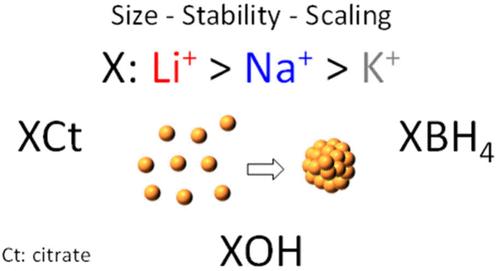积极思考:金纳米颗粒胶体合成中的反离子效应
IF 9.1
1区 材料科学
Q1 CHEMISTRY, MULTIDISCIPLINARY
引用次数: 0
摘要
金纳米颗粒(Au NPs)被广泛研究并广泛应用于催化、传感、医疗等领域。特别是,柠檬酸盐和硼氢化物介导的金纳米粒子的胶体合成是非常受欢迎的。虽然可以合理地预期反阳离子在其中发挥作用,但令人惊讶的是,几乎没有关于反阳离子在柠檬酸盐和硼氢化物介导的Au NPs胶体合成中的作用的研究。结果表明,柠檬酸盐、硼氢化物以及氢氧化物的反离子(Li+、Na+、K+)在金胶体分散体的稳定中起着被忽视的作用。由于较小的阳离子与金属表面之间的相互作用更强,NP的稳定性、尺寸和形状控制程度按Li+ >; Na+ >; K+的顺序递减。这些发现与进一步的基础研究、对合成的改进控制和扩大规模直接相关。本文章由计算机程序翻译,如有差异,请以英文原文为准。

Positive Thinking: Countercation Effects in Colloidal Syntheses of Gold Nanoparticles
Gold nanoparticles (Au NPs) are intensively studied and widely applicable to catalysis, sensing, medical applications, and many more. In particular, citrate- and borohydride- mediated colloidal syntheses of Au NPs are extremely popular. While it can be reasonably expected that countercations have a role to play, there is surprisingly almost no study on the effect of countercations in citrate- and borohydride-mediated colloidal syntheses of Au NPs. It is here shown that the countercation (Li+, Na+, K+) from citrate, borohydride, but also from hydroxide species, plays an overlooked role in the stabilization of gold colloidal dispersions. The stability, size, and degree of shape control over the NP decrease in the order Li+ > Na+ > K+, due to a stronger interaction between the smaller cations and metal surfaces. The findings are directly relevant for further fundamental studies, an improved control of the syntheses and scale-up.
求助全文
通过发布文献求助,成功后即可免费获取论文全文。
去求助
来源期刊

Nano Letters
工程技术-材料科学:综合
CiteScore
16.80
自引率
2.80%
发文量
1182
审稿时长
1.4 months
期刊介绍:
Nano Letters serves as a dynamic platform for promptly disseminating original results in fundamental, applied, and emerging research across all facets of nanoscience and nanotechnology. A pivotal criterion for inclusion within Nano Letters is the convergence of at least two different areas or disciplines, ensuring a rich interdisciplinary scope. The journal is dedicated to fostering exploration in diverse areas, including:
- Experimental and theoretical findings on physical, chemical, and biological phenomena at the nanoscale
- Synthesis, characterization, and processing of organic, inorganic, polymer, and hybrid nanomaterials through physical, chemical, and biological methodologies
- Modeling and simulation of synthetic, assembly, and interaction processes
- Realization of integrated nanostructures and nano-engineered devices exhibiting advanced performance
- Applications of nanoscale materials in living and environmental systems
Nano Letters is committed to advancing and showcasing groundbreaking research that intersects various domains, fostering innovation and collaboration in the ever-evolving field of nanoscience and nanotechnology.
 求助内容:
求助内容: 应助结果提醒方式:
应助结果提醒方式:


